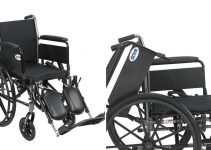Making your home and business accessible is one of the most important things you should consider when planning for your building construction. Therefore, determining how wide a doorway needs to be is essential whether you are wheelchair user or an individual who is trying to make your home or business more accessible.

How wide is a wheelchair?
The standard wheelchair width is usually about 27 inches as a good rule of the thumb while standard interior doors are 28 inches. Besides, the exterior doors are typically about 36 inches wide.

A wheelchair’s width could range from 21 inches to 40 inches for narrow wheelchairs and heavy-duty wheelchairs respectively.
Therefore, before making any purchase, it is advisable to ensure that you measure all the exterior and interior doorways as well as any tight corners. This approach may help narrow down the type of wheelchair to ideal equipment for use indoors, especially in older and smaller homes.
Besides, the manufacturer’s specifications should include the size of every wheelchair.
Apart from the wheelchair width, it is advisable to consider the approach to the door, which includes determining if there is room to maneuver before heading straight through. It is also essential to determine whether you will be required to maneuver or turn immediately once you pass through the door as well as how tight is the turn.
Moreover, you should also determine whether there is a lip or threshold or any break or separation in the flooring. In case there are any of these issues in the flooring, you should consider a small portable wheelchair ramp that will help ease your wheelchair over the barrier.
Finally, the wheelchair dimensions according to ADA, the overall width of a large rear wheel is 9 inches wider than the seat for a manual wheelchair. For instance, a 27 inches wheelchair will feature an 18 inches wide seat.
If you have a transport wheelchair, then you need to add 5 inches to the seat width to determine the wheelchair width. For example, an 18 inches wide seat would make a 23 inches transport wheelchair.
Usually, heavy-duty power wheelchairs can come with a wheelchair width of up to 32 inches while most standard foldable power wheelchairs are 25 inches wide.
Why do you need to do wheelchair sizing?
The width of a doorway might seem like a non-issue to some people, but it is what takes to ensure that your new business or home plan is more accessible through a wheelchair or any other mobility equipment.
Most people seek to determine the suitable width for a wheelchair since either them or a family member requires wheelchair accessibility. Moreover, some are purchasing their retirement homes, which mean that they would like to include universal design features. This includes relatively wider doorways that would accommodate a wheelchair while some are considering the higher resale value.
Issues with movements can be challenging, but acquiring a wheelchair or scooter (Click to see our reviews for off road mobility scooter and foldable electric scooter) could be the best decision for your happiness and health. It is, however, essential to determine how wide does a doorway need to be for a wheelchair before purchasing one or designing your home or a business building. Therefore, it is advisable to consider the measurements of the home when looking for the right wheelchair.
If you already have a good wheelchair, then you need to change your doorway according to the width of your wheelchair.
Banging into doorway frames could be risky and frustrating to individuals who use wheelchairs and can also diminish the retail value for an apartment or house.
Many doorways usually have widths of 23 inches making the size too small for wheelchairbound individuals to enter any room safely and comfortably. It also makes it hard even to get the side wheels fit through the framing of the doorway or entrances.
Finally, trying to access any facility through the doorway that does not meet the ADA standards is almost impossible for a normal wheelchair user. The minimum standard wheelchair width that guarantees individuals who use wheelchairs the ability to access a wide range of facilities, including grocery stores and health clinics helps improve their lives.
It can significantly increase the level of independence in their life, which enables them to continue their day-to-day activities with the services of a caregiver.
How wide does a doorway need to be for a wheelchair?

In the United States, the government has set forth standard guidelines that gauge how wide a doorway should be. This influences the wheelchair dimensions according to ADA.
The ADA accessibility standard dictates that 32 inches are the minimum width for a doorway opening from the door face to the doorstep.
This measurement provides the minimum amount of clearance that is required for wheelchair users to get through with their chair comfortably.
The doorway can be extended to 36 inches even though it is not a requirement by law to allow for a more comfortable fit.
However, some wheelchairs like transport wheelchairs are slimmer than the standard wheelchairs. This will enable them to comfortably fit through spaces that are not suitable for standard wheelchairs.
The ADA is also charged with the responsibility to strictly enforce the standard wheelchair width for doors to enable wheelchair users to access any room in the US without any problem.
As mentioned above, standard exterior doors are generally 36 inches wide while interior doors are 28 inches. It is imperative to consider mobility equipment that has a wheelchair width that is compatible with the exterior and interior doors size for a comfortable fit.
Want to make wheelchair user feel more comfortable? You can choose to buy a wheelchair cushion.
Helpful Tips on the Wheelchair Width
The width that you require for the doorways and hallways in your home or business depends on the kind of access that you want.
- For a door, the minimum clear width is 32 inches while the 36 inches is the minimum width for a hall.
- The minimum passage width for one ambulatory person or wheelchair is 48 inches
- The minimum space for a T-shaped turn of 180 degrees in all directions requires 36 inches.
ADA Requirements for Wheelchairs Use
The Americans with Disabilities Act (ADA) has set the recommendations listed below to ensure that all places are more accessible to wheelchair users. These include:
- The standard wheelchair width for door should be between 32 inches to a maximum of 48 inches to allow them to accommodate most wheelchairs. On the other hand, hallways should be 36 inches.
- Hardware such as locks and handles needs not to be higher than 48 inches from the floor.
- The standard door’s height should be 80 inches
- ADA also recommends that a ramp is required for thresholds that are higher than ½ inch.
Other factors should consider when adapting a doorway to a wheelchair
Apart from wheelchair width, there are other factors to consider when adjusting a doorway to mobility equipment. Here are some of the factors that you should consider:
- Turning space
Usually, standard wheelchairs will require about 1500 mm x 1500 mm space to rotate through 360 degrees since an empty wheelchair has approximately 635 mm. Additional space is needed for each side of the equipment to allow the user to propel it manually.
Moreover, there are various types and sizes of both electric and manual wheelchair, which can take up a more considerable space than the standard ones. This includes wheelchairs with elevating leg-rests or reclining backrests.
- Ramp access
A level of access to the property is more recommended where possible. However, for ramp access, the gradient should not be steeper than 1:20 while its width should be a minimum of 1000 mm. It is advisable to avoid short and steep ramps as they can cause the wheelchair assistant or user to lose control of the chair or cause the wheelchair to overburden. Besides, it is more difficult for wheelchair assistant to push wheelchair-bound individuals or the users to propel themselves up the ramp.
- Doors design
The other important to consider when adapting your door to a wheelchair is the design and features on the doors. It is imperative for all doors to be suitable for grab rails or pulls. These are required to help in closing and closing of the door. In addition, all doors should feature door stops were needed to protect other doors, walls, and should swing beyond 90 degrees to allow the users to fit the wheelchair comfortably.
It is also essential to ensure that there is space provided to maneuver the wheelchair beyond the door swing. Moreover, kick plates should be fitted at the bottom of the door and should be 350 mm high to prevent damage by the mobility equipment.
Finally, sliding doors should operate efficiently and smoothly where they are provided, with a minimum clear opening of 850 mm. It is also important to position a vertical handrail that is easy to grip 800 mm from the ground.
How wide does a ramp need to be for a wheelchair

As you might know, ramps are usually built to help enhance home accessibility for individuals who cannot use stairs or require less stress or the gentler way to leave or enter their property.
Careful planning is needed when making your home more accessible to make sure that ramp meets all the needs of the home occupant’s. It also ensures that the ramp complies with the building requirements, is sturdy and secure for use in different weather conditions.
Here some of the factors to consider when building a wheelchair ramp:
- Home Entry
There are several issues that influence the choice of the door to build the ramp. These include if the doorway has existing features such as platforms, stairs, and porches that can accommodate a ramp easily and ease of access to the doorway from various positions within the house.
- Space Limitations
The space available and obstacles in a given area such as buildings, trees and walkways limits the design of the ramp in many aspects. Therefore, it can greatly influence where a ramp can be located. If you have a limited space, you can construct a U-shaped ramp since the design requires a relatively smaller space.
- Ramp Width
The minimum standard inside width of the opening between the opposing handrails should be at least 36 inches to allow it to fit a wheelchair. Therefore, it is advisable to build the ramp 42-inches wide to cater for the 11/2-inch spacing between any surface and the handrail.
- Ramp Rise
Any particular ramp segment is required to have a maximum rise of up to 30 inches. Besides, a flat rest platform must be provided after a 30 inches rise in elevation before the slope continues. The landings must be provided at the bottom and top of each and every ramp and should always be a minimum of 60 inches in length and its width should at least match that of the ramp itself. Moreover, a ramp that meant for direction changes must be 60 by 60 inches at least.
- Ramp Size and Slope
The other notable feature to consider when building a ramp is the angle of the ramp surfaces and the run or length of the ramp. The slope of the ramp will influence the expense involved, layout requirements and the ultimate usefulness of the ramp.
A slope is expressed as a ratio since as you may know it is the angular relationship of the rise (vertical height) to the run (projection or horizontal length). The most commonly used slope in constructing ramps is 1:12, as it is also the recommended slope by the ADA. Therefore, if your porch is 24 inches high, you will require a 24-foot ramp for safe and comfortable wheelchair access.
- Ramp Materials
The ideal material for the ramp dramatically depends on your personal preference. However, it is advisable to choose slip-resistant, firm and stable in all weather conditions. It is advisable to select composite materials that meet ADA standards for low-maintenance and slip resistance in wet weather such as Trex Accents. In addition, it is also imperative to consider easy-maintenance handrail materials as they allow for comfortable use. These materials are suitable for individuals who rely on a ramp to maintain an independent lifestyle.
Bottom line
Overall, determining how wide a wheelchair is is the first step for ensuring that your home or business is more accessible for individuals who depend on wheelchairs to maintain an independent lifestyle. With the right information about the standard wheelchair width, it is much easier to achieve success in the development of greater accessibility. The information above will also guide on how wide a wheelchair should be for it to comfortably fit in different doorways. If you want to have a longer journey, you can purchase a wheelchair carrier for the back of a vehicle.



